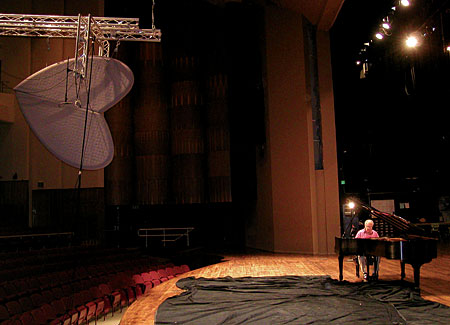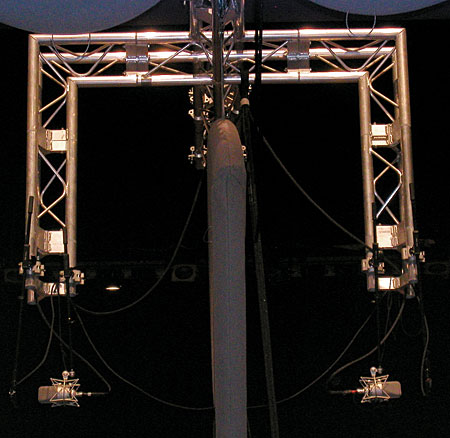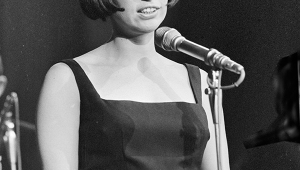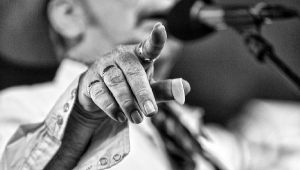| Columns Retired Columns & Blogs |
Beethoven's Diabelli Variations: the Finest Hour of Piano Music in the World
John Atkinson on the Recording
"This will fix it!" Kimber Kable's Ray Kimber placed some acoustic baffles around the table on which sat my Apple TiBook. We were recording Robert Silverman performing one of Beethoven's masterworks for piano, the Diabelli Variations, Op.120, and I had been bothered by a faint whistle underlying the music. It turned out to be the sound of my laptop's fan, an unforeseen drawback of my decision to dispense with tape and record straight to hard drive for the August 2004 sessions. We had already had a problem with a slight slapback echo from the balcony of the Austad Auditorium at Weber State University in Utah, which Ray had fixed with drapes, and a problem with low-frequency rumble from airplanes overflying the college campus during one session had been solved by Ray phoning the air traffic control tower. However, even Ray couldn't deal with thunder, so that was the one session we decided to finish early.
Footnote 1: The making of Robert Silverman's set of the complete Beethoven piano sonatas is described here. The set is available from our secure e-commerce page.
"This will fix it!" Kimber Kable's Ray Kimber placed some acoustic baffles around the table on which sat my Apple TiBook. We were recording Robert Silverman performing one of Beethoven's masterworks for piano, the Diabelli Variations, Op.120, and I had been bothered by a faint whistle underlying the music. It turned out to be the sound of my laptop's fan, an unforeseen drawback of my decision to dispense with tape and record straight to hard drive for the August 2004 sessions. We had already had a problem with a slight slapback echo from the balcony of the Austad Auditorium at Weber State University in Utah, which Ray had fixed with drapes, and a problem with low-frequency rumble from airplanes overflying the college campus during one session had been solved by Ray phoning the air traffic control tower. However, even Ray couldn't deal with thunder, so that was the one session we decided to finish early.

When I recorded Bob performing all 32 of Beethoven's piano sonatas in Santa Monica in 2000 (footnote 1), we had discussed a follow-up recording of the Diabellis, but, with one thing and another, the idea had slid back and back—until I gave a listen to some of Ray Kimber's IsoMike recordings at the 2003 Home Entertainment Show in San Francisco. The image specificity, the lack of coloration, the low-frequency extension, the sense of being there were all first-rate, and when I talked with Ray about his technique, he invited me to use IsoMike for a Stereophile recording. I didn't need to be asked twice!
We would spend five days in Utah during the 2004 summer break. Bob suggested that, as well as the Diabellis, we record Beethoven's little-performed 32 Variations on an Original Theme in C Minor, WoO 80; Ray suggested that, as well as recording the piano in conventional PCM for CD release, we record it in DSD and surround for a possible SACD release. The game was afoot.
IsoMiking
One of the perennial problems for the live recordist is that the microphone array that best captures the image of the performers—coincident or near-coincident directional mikes—falls down when it comes to correctly capturing tonal colors, while the mike array that best preserves tonal color and produces a satisfying sense of bloom—spaced omnis—produces an amorphous, unstable blob of sound rather than a true stereo image. For Stereophile's own recordings and for the CDs I engineer for Minneapolis choral group Cantus, I have attempted to get the best of both worlds by using both coincident and spaced microphone pairs, time-aligning the outputs for sound sources in the center of the stage and adjusting the relative levels of each pair in the mixdown, a sometimes time-consuming process.

But what Ray Kimber has achieved with his IsoMike is to get both tonal accuracy and a stable, accurate image from a single pair of spaced omnis. Following the complexity of my June 2004 Cantus sessions, reported on in the November 2005 issue, in which I had added third and fourth pairs of mikes, the idea of using just two microphones was very appealing. And, as I said earlier, I could simplify the process even further by dispensing with tape and using my laptop as a recorder.
So what is IsoMike?
Ray's invention is described on the IsoMike website. A fairly large, vertical, heart-shaped baffle is placed between two omni mikes spaced about 48" apart. Down to a frequency related to the size of the baffle, the IsoMike will isolate the left and right microphones from "seeing" each other. Compared with a conventional spaced-omni recording, the sound-pressure level of sound sources on the left of the stage will be reduced in the right-hand microphone and vice versa, resulting in a stereo image defined by differing amplitudes in the stereo channels. As the brain detects sound-source directions in the treble by the differences in amplitude in the soundwaves reaching the ears, the IsoMike captures the appropriate imaging information in the upper midrange and treble. At low frequencies, where the sonic wavelengths begin to exceed the dimensions of the IsoMike, the brain detects sound-source directions by the differences in timing in the soundwaves reaching the ears—ie, a sound on the left reaches the left ear before the right—and the IsoMike array preserves that timing information, albeit in an exaggerated manner, given that the mike spacing is wider than the 7" or so that separates the human ears. For stereo playback, that exaggeration adds to the sense of "bloom," I have found.

The heart shape of the IsoMike baffle prevents reflections of sound from reaching the microphones in a focused manner and widens the transition region between where it provides effective baffling and where it doesn't. Its construction is complex. From the IsoMike website: "There is a complex mechanical design under the fabric shell of the baffles, which takes well over 100 hours to construct. The baffle construction is designed to absorb sound from a medium to high pitch or frequency. Below that medium pitch, sound energy is not so easy to absorb, that is where the shape of the baffle becomes effective. As those lower frequencies flow around the heart shape, there is a multiplicity of path lengths that scatters the energy as a function of time, which is as effective as absorbing energy."

For stereo operation, the IsoMike sometimes also has two smaller egg-shaped baffles positioned behind and below the main baffle that control the amount of energy reaching the microphones from the back of the auditorium. But as you can see from the photograph, Ray extended the IsoMike concept for the Silverman sessions with additional baffling to allow four microphones to be used, for surround purposes.

I had brought along my pair of high-voltage DPA 4003s, as I knew Ray also had a pair of these transparent-sounding omnis. However, Ray had recently acquired a matched quintet of Neumann M150s. This is a remake of the German manufacturer's classic tubed M50 that had been used for some "Golden Age" classical recordings by Decca and RCA, and he proposed we use four of these instead. We compared the front channels captured by the DPAs against the Neumanns; both captured the low-frequency weight of the Steinway in full measure, but while the ½"-capsule DPAs had the edge, I thought, in top-octave air, the M150s produced a midrange that was positively creamy. Those would be what we would use.
On Location
My rig, from which I would produce the CD, was simplicity itself. I fed the front-channel outputs of the eight-channel Millennia Media HV-3D mike preamp we were using to a dCS 904 A/D converter running at 88.2kHz with 24-bit resolution. The dCS offers a choice of anti-aliasing filters. I used Filter 4, which trades off better time-domain performance against a slower rate of rollout above half the sample rate. Because of the relative lack of energy in a piano's spectrum above 15kHz or so, I felt this was acceptable.
The converter's AES/EBU digital output was taken to the digital input of a Metric Halo MIO 2882 FireWire interface, which in turn was connected to my Apple PowerBook. I captured the two channels as AIF files to the laptop's internal hard drive using the Bias Peak 4.0 program, copying these to an external drive during breaks. Because I am paranoid about hard drives going bad, I also copied the entire five days' worth of 24/88.2 files to my iPod before flying home, using it as a conventional external drive.
Footnote 1: The making of Robert Silverman's set of the complete Beethoven piano sonatas is described here. The set is available from our secure e-commerce page.
- Log in or register to post comments



































